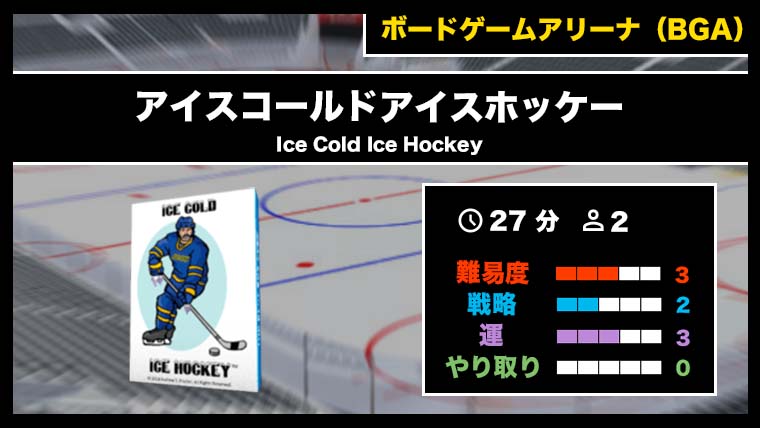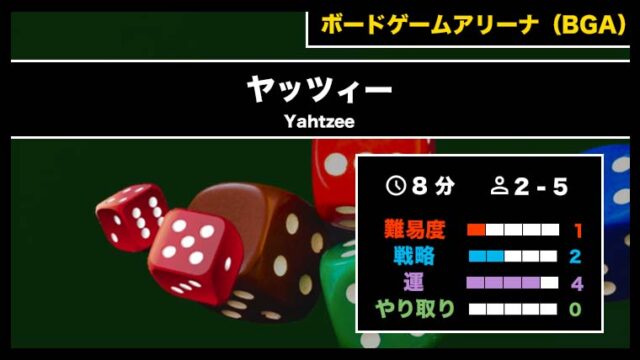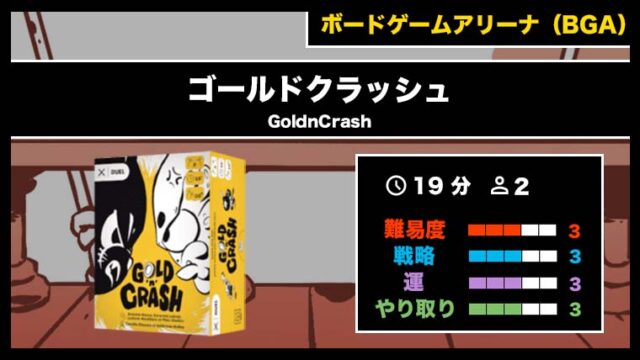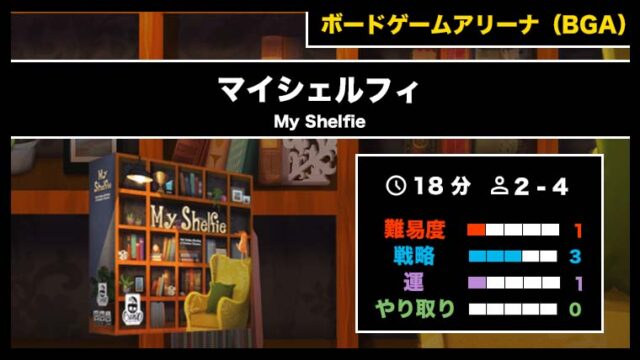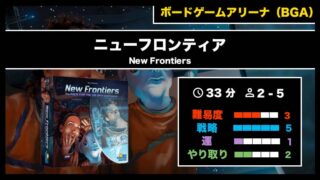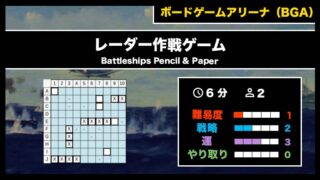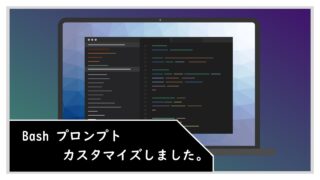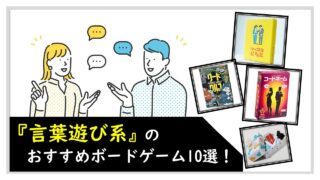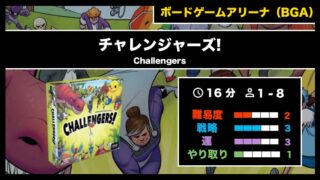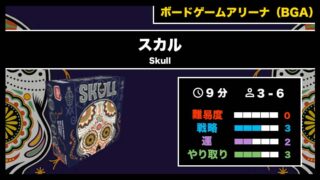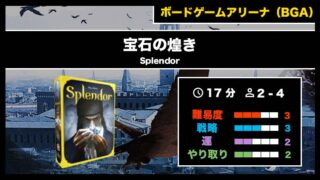『アイスコールドアイスホッケー(Ice Cold Ice Hockey)(BGA)』の遊び方・魅力をご紹介!
| ボードゲームの基本情報 | |||
|---|---|---|---|
| タイトル | アイスコールドアイスホッケー(Ice Cold Ice Hockey) | ||
| 特徴 | アイスコールドアイスホッケーは、プロのアイスホッケーの興奮をすべてシミュレートするように設計されている思考型のカードゲームです。 64枚のカードで構成されたアクションデッキと、包括的でわかりやすいルールで、ほぼ完全なゲームを構成しています。カードは、パス、スケート、シュート、ディフェンス、ブロック、ゴールテンディングなど多目的に使用できます。カードの組み合わせと的確な判断が鍵を握っています。 ルーズパック、ブロックされたシュート、ブレイクエイ、戦い、勢い、ペナルティ、スーパーセーブなど、すべてがアイスコールドアイスホッケーにはあります。 BGAアダプションではBGA専用に設計されたカードを使用していますが、オリジナルのカードデザインも提供しています。 | ||
| プレイ人数 | 2 人 | プレイ時間 | 27 分 |
| ゲームデザイナー | Andrew S. Fischer | 複雑さ | 3 |
| アートワーク | Andrew S. Fischer | 戦略 | 2 |
| エディター | Web published | 運 | 3 |
| 発売日 | 2014 | やり取り | 0 |
※画像・基本情報はボードゲームアリーナ公式HPより
アイスコールドアイスホッケー(Ice Cold Ice Hockey)とは?
パックをシュートしてゴールを決めてください。 アウトサイドショット (O/S) は、対戦相手のブルーラインのすぐ内側にある「ポイント」からの、割合の低いショットです。
一方、インサイド ショット (I/S) は通常、相手のゴールキーパーに近い「スロット」から行われ、ゴールを決める可能性が高くなります。 ゲーム全体を通して、パス、スケート、パックのダンピング アンド チェイスなど、I/S を設定しようとします。
アイスコールドアイスホッケー(Ice Cold Ice Hockey)の遊び方
ゲームの準備
内容物
・アクションカード(64枚)
・リンクカード(3枚)
・サマリーカード(1枚)
・パックトークン(1個)
準備
・アイスホッケーリンクを作成
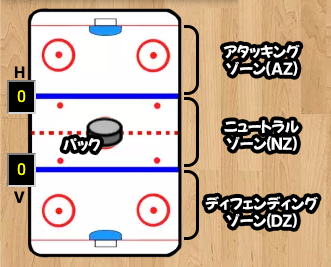
3枚のリンクカードを並べて、アイスホッケーリンクを作り、中央にパックトークンを配置します。
画面におけるリンクの下部がディフェンディングゾーン(DZ)、中央がニュートラルゾーン(NZ)、上部がアタッキングゾーン(AZ)と呼びます。
・アクションカードを配る
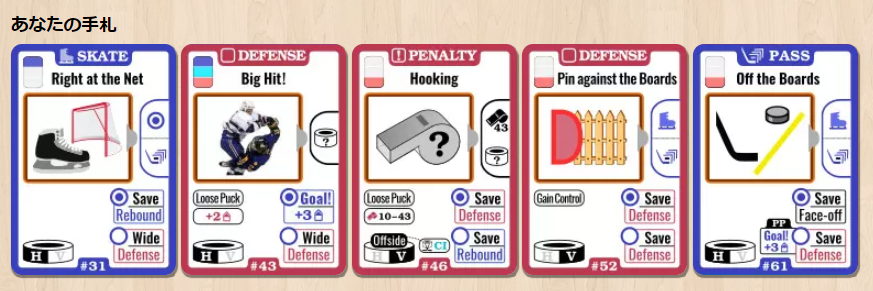
アクションカード(64枚)をシャッフルし、各プレイヤーに5枚ずつ配ります。
残りのカードは山札として置いておきます。
・ホーム/ビジターを決める
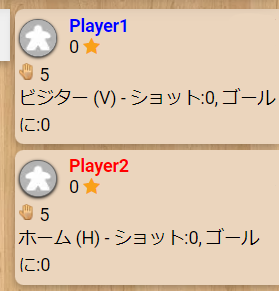
各プレイヤーがそれぞれ、ホーム(H)/ビジター(V)かを決めます。(※BGAでは、自動で決まります)
フェイスオフ時に、パックのコントロール権を決めるのに使用されます。それぞれに差は特にありません。
・フェイスオフ
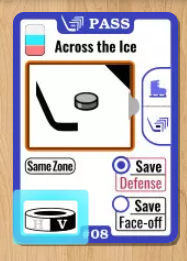
フェイスオフでは、パックの所有者を決めます。デッキからカードを1枚公開し、左下のパックを確認します。
『H』なら、ホームのプレイヤーがパックを所有し、『V』なら、ビジターがパックを所有します。
パックを持っているプレイヤーが、攻撃側になります。
最初の画面は以下のようになります
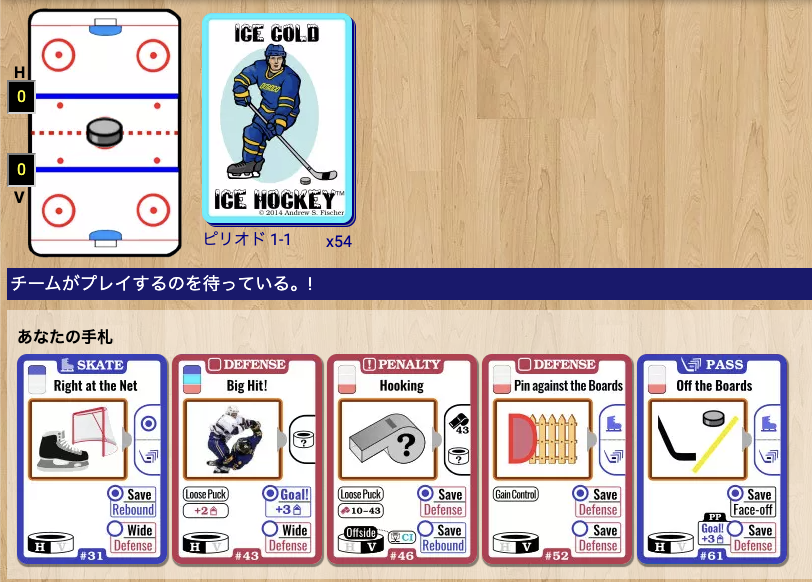
ゲームの流れ
基本的には、攻撃側のプレイヤーがアクションを行なっていきます。
攻撃側のアクションにより、必要であれば守備側もアクションを行ないます。
1. 攻撃側アクション
2. 守備側アクション
2. 攻撃側アクション
攻撃側プレイヤーとして、自分のターンに次のアクションのいずれかを選択します。
ディフェンディングゾーン(DZ)にいる場合
・『パス』または『スケートカード』を使用する
・カードを1枚捨てニュートラルゾーン(NZ)に移動する
・アタッキングゾーン(NZ)に移動する
ニュートラルゾーン(NZ)にいる場合
・『パス』または『スケートカード』を使用する
・カードを1枚捨てアタッキングゾーン(AZ)に移動する
アタッキングゾーン(AZ)にいる場合
・『パス』または『スケートカード』を使用する
・『アウトサイドショット』を打つ
・『インサイドショット』を使用する
■【DZ/NZ/AZ】『パス』または『スケートカード』を使用する
新しいオフェンシブプレイの開始でない場合、カードの上部にあるタイプ/アイコンは、最後にプレイしたカードの右中央にあるパスまたはスケートアイコンと一致しなければなりません。さらに、パックは現在、カードの左上にあるカラーリンクゾーンのいずれかに位置していなければなりません。I/Sを許可するパス/スケートカードには、右中央にドット付きの円アイコンがあります。
■【DZ】カードを1枚捨てニュートラルゾーン(NZ)に移動する
カードを 1 枚捨てて、パックをディフェンシブ ゾーンからセンターアイスに置きます。
対戦相手が所有権を獲得し、新しいシーケンスを開始します。
■【DZ】アタッキングゾーン(NZ)に移動する
アイシングに呼ばれる確率は50%です。
(対戦相手が「タッチアップ」を選択した場合は免除されます。)
これらの違反は、H/V (ホーム/ビジター) チェック中に呼び出され、対決になる可能性があります。
■【NZ】カードを1枚捨てアタッキングゾーン(AZ)に移動する
カードを 1 枚捨てて、パックをディフェンシブ ゾーンからセンターアイスに置きます。
対戦相手が所有権を獲得し、新しいシーケンスを開始します。
■【AZ】『アウトサイドショット』を打つ
5. パックがオフェンシブ ゾーンにあるときにアウトサイド ショットを打つ (捨てない)
パックを持っている必要があります。 このアクションはフリー アクションです。 カードはプレイされません。 デッキの一番上のカードがショットの結果を提供します。
■【AZ】『インサイドショット』を使用する
インサイド ショット カードには、上部中央に丸とドットのアイコンがあります。
デッキの一番上のカードがショットの結果を提供します。 右中央のインサイド ショットには赤いブロック ショット アイコンがあり、防御側のプレーヤーは I/S ショット ブロック カードをプレイできます。 一部の I/S カードには、感嘆符の付いた四角形があり、防御側のプレーヤーが防御側のカードをプレイして、ペナルティが発生する可能性があります。
これらの違反は、H/V (ホーム/ビジター) チェック中に呼び出され、対決になる可能性があります。
第3ピリオドで15枚のカードが残っている状態で、点数が負けており、NZ またはAZで、パックを所持している場合 (または、これらのゾーンのいずれかで対決が行われようとしている場合)、ゴールキーパーを引っ張ることができます。
その後、ゴールキーパーがネットに戻るまで、6 枚のカードでプレイします。 これは、プレーの停止中にのみ行うことができます。 ゲームが同点の場合、またはDZでフェイスオフが発生した場合は、ゴールキーパーをネットに戻さなければなりません。
3. 守備側アクション
・防御カードを使用する
・ショットのブロックカードを使用する
・防御モード
■ 防御カードを使用する
攻撃側のプレイヤーが右中央に(丸みを帯びた)赤い四角があるカードをプレイした場合、対戦相手は防御側のカードをプレイできます。 赤い四角と防御カードには、2 つの異なるタイプがあります。上部中央の赤い四角または感嘆符付きの赤い四角です。
直前にプレイされたオフェンシブカードがスケートカードの場合、ディフェンシブカードの左上のリンクアイコンは、パックの現在のゾーンと一致するセクションに色が付いていなければなりません。 直前にプレイされたオフェンシブカードがパスカードの場合、ディフェンシブカードの左上のリンクアイコンは、パックの行き先ゾーンと一致するセクションに色が付いていなければなりません。
2つのディフェンシブカード「パックを奪う」は、パスカードに対してスケートカードのように機能します。つまり、自分のOZでパックを所持します。
■ ショットのブロックカードを使用する
相手がアウトサイドショットまたはインサイドショットを行った場合、ショットのブロックカードを持っている場合は、ショットをブロックすることができます。
この場合、どちらもルーズパックになります。
■ 防御モード
対戦相手よりも多くのゴールを決めた場合、センターアイスからオフェンシブゾーンにパックをダンプして対戦相手がポゼッションを得ることを選択できます。
この手順により、ディフェンシブカードを獲得する可能性が高くなり、クロックから時間を消費できます。
中央上部に感嘆符付きの赤い四角がある防御カードは、プレイ時にペナルティが発生する可能性があります。 H/V (Home/Visitor) チェック中に、他のペナルティがコールされる場合があります。 罰則により、アウトサイドおよび/またはインサイドのパワー プレー ショットが何度も発生します。 カード #44 (チープ ショット) をプレイすると、メジャー ペナルティと 6 回のシュートが発生する可能性があり、複数のゴールを決める可能性があります。 複数のペナルティとペナルティ ショットが発生する可能性があります。
これらは、いくつかの防御カードのプレイやその他の状況の後に発生する可能性があります。 H/V チェックにより、どちらのチームがパックの所有権を獲得するかが決定されます。 デッキの一番上のカードの左下のアイコンで決まります。
ゴール、ゴールキーパーの見事なセーブ、大ヒット、チープ ショット、ファイトは、プレイヤーの手札に余分なカードを引く結果となる可能性があります。 この手のサイズの増加は一時的なものです。
ゲームの終了条件
山札が全て無くなれば、ゲーム終了となります。
(※基本ゲームの場合、3ピリオド(ラウンド)繰り返されます)
多くの得点を獲得しているプレイヤーが勝利となります。
